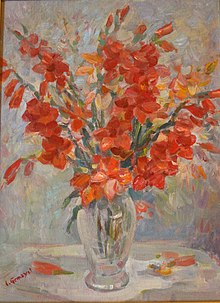César Gemayel
César Gemayel | |
|---|---|
 Still-Life by César Gemayel | |
| Born | 1898 |
| Died | 1958 |
| Nationality | Lebanese |
| Education | Khalil Saleeby in Beirut |
| Known for | Painter; co-founder of the Lebanese Academy of Fine Arts |
| Movement | Modern art |
César Gemayel (1898 in Ain al Touffaha near Bikfaya, Ottoman Empire – 1958 in Beirut, Lebanon) was a notable Lebanese painter, who helped to lay the foundations of a modern Lebanese art movement.
Life and career
[edit]
Gemayel received his early art education from Khalil Saleeby in Beirut.
Gemayel was a pre-eminently sensual artist. His themes - the female nude, glowing flowers, landscapes green and red, dances and "dabkés", the occasional epic evocation - are the product of his thirst for living expressed through painting.
Along with artists, Mustafa Farrukh (1901-1957), Omar Onsi (1901-1969), Saliba Douaihy (Saliba Duwaihi) (b. 1915), Youssef Howayek, Daoud Corm (1852-1930), and Rachid Wehbi (Rachid Wahbah)(b. 1917), Gemayel is regarded as a pioneer, having laid the foundations for a modern art movement in Lebanon. These artists established originality and freedom of expression that had never before been seen in Lebanon. [1]
In 1943, Gemayel and Alexis Boutros founded the Lebanese Academy of Fine Arts (French: L'Académie libanaise des Beaux-Arts), also known as ALBA.[citation needed]
The artist is portrayed on a Lebanese airmail stamp issued in 1974 in recognition of his contribution to the visual arts.
References
[edit]- ^ Zuhur, S. (ed.), Colors of Enchantment: Theater, Dance, Music, and the Visual Arts of the Middle East, American University of Cairo Press, 2001, p. 369
External links
[edit]
